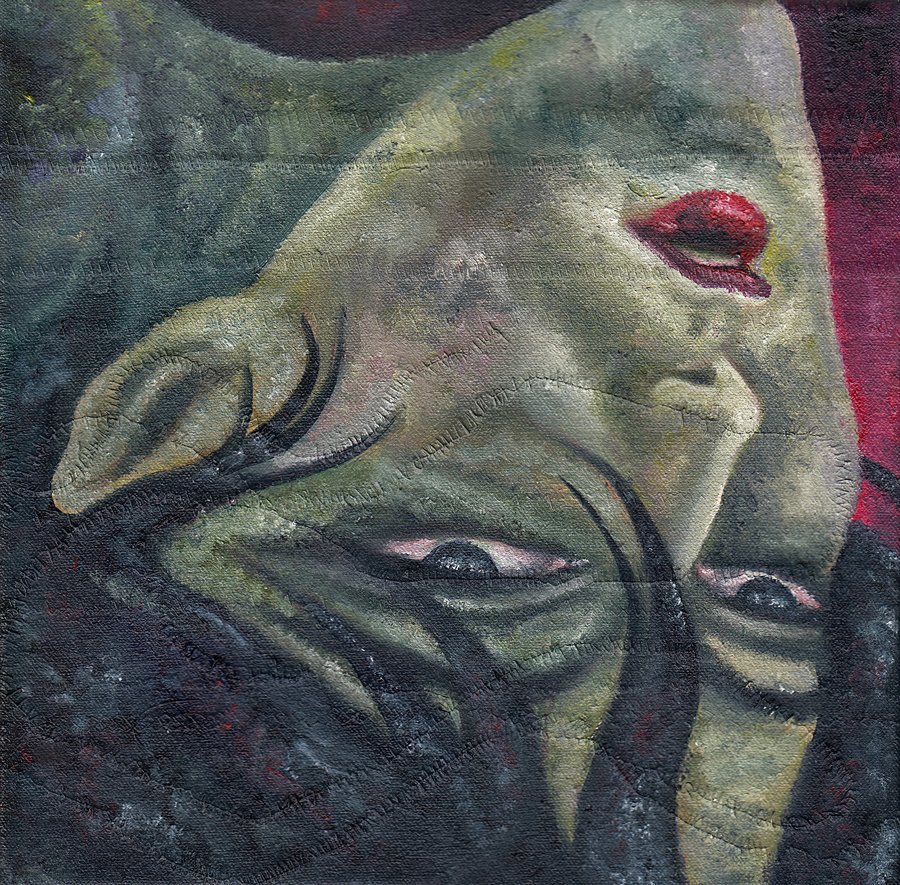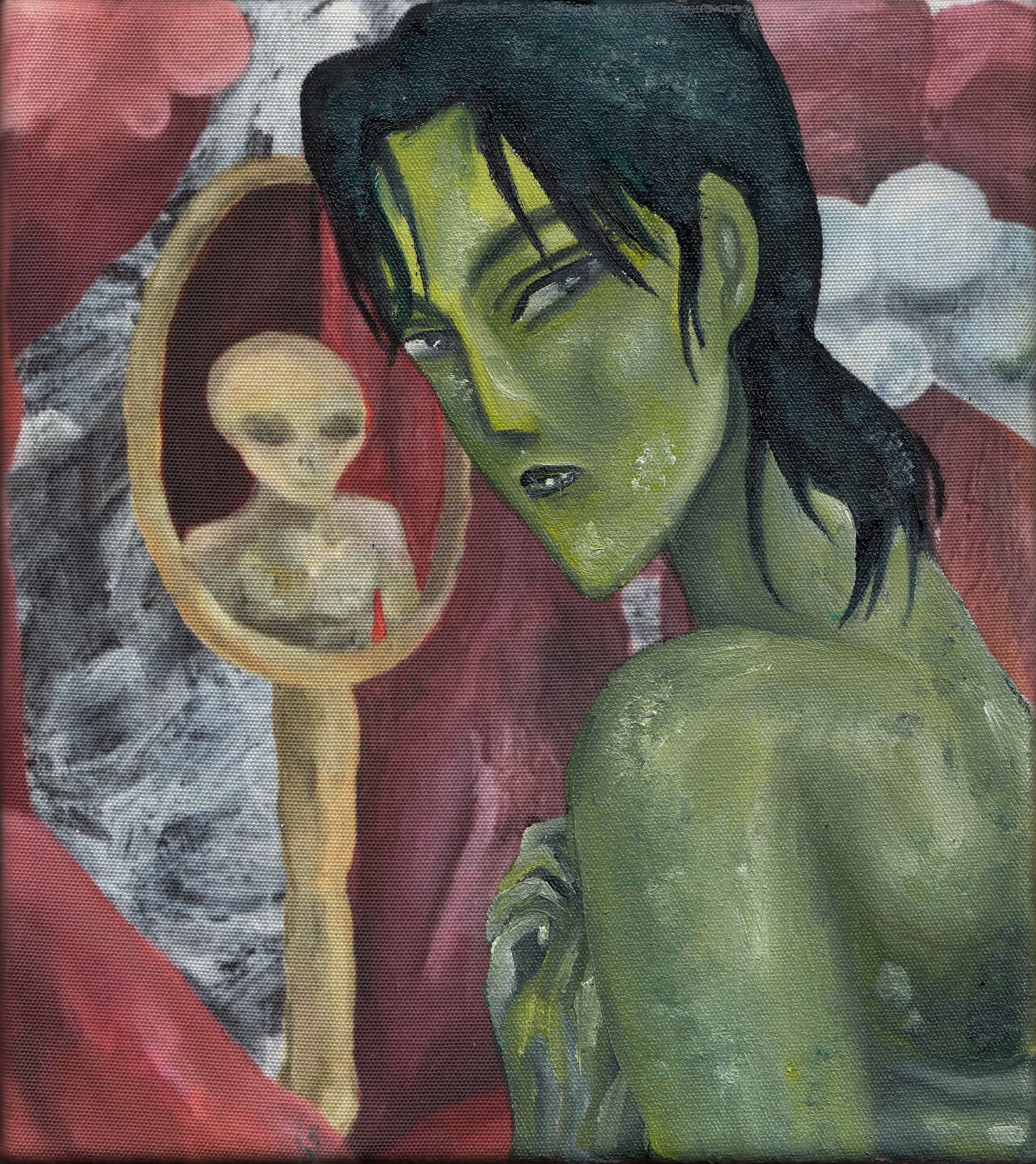Vilte Fuller

“The horror, sci-fi and comedy narratives that I enjoy watching in movies I attempt to translate into my oil paintings.”
Interview by Charlie Mills
Could you tell us a bit about yourselves and your background? Where did you study?
I was born in Klaipeda, Lithuania and grew up in rural Kent. With very few social activity opportunities in the area, I would spend a lot of time entertaining myself by obsessively drawing bad portraits of the Twilight cast members. As a teenager, I either wanted to work in finance or in art. I didn’t know anything about either world, nor was I ever exposed to them but naively they looked glamorous to me and I somewhat knew how the stock market worked; however my math GCSEs were not up to par so the art route I went. I graduated from The Glasgow School of Art in 2018 and have been living and working in London ever since.
The world you create through this tension is suitably surreal, blending body-horror tropes with suggestions of food-porn, digital subcultures and your own Lithuanian heritage. Yet despite their uncanny surrealism, each work could be seen as part of an ongoing narrative or greater cosmic chain of events. Is it your ambition to evoke a consistent universe in which your paintings take place — or has this been an accidental effect of their surreal origins?
I do enjoy creating a consistent universe and reusing motifs and characters in different paintings as if they are a part of a franchise. The gherkin is a constant, I find it to be rather expressive as an object as it can’t ever be taken seriously. You can paint the saddest, most tragic scene but if a gherkin is hanging about in the composition it becomes facetious.
Your paintings are balanced between opposing extremes of horror and humour. On the one hand, you take reference from the malevolent drawing of mangaka Junji Ito, and on the other, a litany of pop-cultural and internet-based imagery that runs from the pickle-obsessed culture of Rick and Morty fans to Futurama’s Zoidberg and Dvaro cottage cheese. How do you source your imagery and what does it take for a subject matter or image to make you tick?
The truth is I’ve always wanted to make horror films, unfortunately, I’m a terrible filmmaker but I can paint. The horror, sci-fi and comedy narratives that I enjoy watching in movies I attempt to translate into my oil paintings. I often see the small-scale works as screenshots or thumbnails of a larger narrative that no one else but me will get to know. Recently I have been taking a lot of influence from Lithuanian history, specifically to create paintings that play on the dystopian landscapes of post-Soviet architecture, domestic objects and my personal nostalgia for the country.
There is a fantastic Instagram page called @90s_Lithuania curated by Elena Krukonytė that I have taken many source images from. The page documents important political and cultural moments in Lithuania specifically tailored for the generation born after the Soviet collapse. There isn’t a particular formula as to where I source my ideas, it is very much instinctual and quite often the works I make are an extension of my personal interests such as my obsession with pickling and fermenting vegetables and adoration for Junji Ito’s storytelling.
Superzoom Gallery, 2021
The Shuttle to the Moon Has Crashed, and Now I'm Falling, 2021
Brotherhood, 2021
I Was Meant to Go Home but My Flight Got Deleted, 2021
A notable aspect of your painting is the variety of scale you employ. From canvases that measure 8 x 10 cm to large paintings that measure 120 x 150 cm. The effect ranges from emphasising a vignette-style of graphic imagery, to more epic sensations of psychological mood and inference. What do you consider when approaching the scale of a painting? and when working towards an exhibition, how do you balance the different scales within an overall narrative?
My heart belongs to tiny paintings but when it comes to exhibitions I have to be rather conscious of the fact that bigger is quite often better in a gallery context. What I consider when I approach the scale of a painting depends on how much physical labour I wish to put into it and if it’s worth it. If my composition idea is quite minimal I don’t feel like I need to exhaust it on a large canvas but if there are more complexities, more characters, more drama, it means it’s time to exercise.
When working towards an exhibition my general rule of thumb is to make lots of tiny works and a couple of big ones. I feel like the majority of my paintings work well with one another as they all follow a similar narrative so I’m never too worried about them, whatever size or colour palette they may be.
In parallel to your paintings, you have also created and produced the first volume of a graphic novel called Jars and Rhinoplasties. It is wonderful to see the translation between your paintings and the novel, in both subject matter and form, and it is interesting to think about this translation when unpacking some of the motifs found in your work. What inspired you to make the novel, what is the storyline and how did you find the experience?
I wanted to spend some time working on a longer-form project that incorporated many of the characters that I was painting on a small scale; to flesh them out and give them more coherent storylines. The story follows residents of a town where all women have exactly the same nose job and strange things start to happen when people eat gherkins. I have so much respect for people who illustrate and write and make any sort of publications because it is ridiculously draining, painting is a luxury in comparison. I’m not sure if I’ll ever find the time again to make another volume that lockdown conditions were able to give me for the first one.
It's Difficult to Know Which Dye to Pick, 2021
Friends in High Places, 2021
Jars and Rhinoplasties Vol.1 , Good Press Glasgow, 2021
Jars and Rhinoplasties Vol.1 , Good Press Glasgow, 2021
You are currently preparing for an upcoming solo show at Niru Ratnam Gallery in London, which will open to the public on March 10th, 2022. Can you tell us about the key concepts behind the show and what we can expect when we visit?
I feel like this show is my not-so-secret love letter to Lithuania. The works I have been making for it are much darker and grittier than things I have done before. I became really obsessed with the colour ‘Chromium Oxide Green’ last summer which is pretty much the exact same shade as the former KGB prison walls in Vilnius, Lithuania. So there will be a lot of green, a lot of Baltic foods, Lomonosov porcelain-inspired characters and concrete buildings. I have also been working on a few ceramics with my friend and artist Lily Morgan.
Is there anything new and exciting in the pipeline you would like to tell us about?
I will be participating in a few group shows in Europe this coming spring which has not yet been announced. I am currently in the process of creating my largest paintings yet for them, so am interested to see how that will pan out.
All images are courtesy of the artist
Date of publication: 18/02/22







